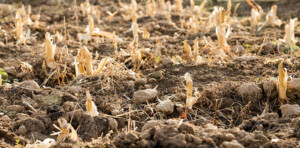- As a farmer and ag salesman at Huma, I’m always on the lookout for products that can make farming easier and more efficient. That’s how I first came across MICROHUMIC® OM at the 2024 Commodity Classic, right after I joined Huma. While working in our booth, I was chatting with our CEO, Lyndon Smith, when my dad mentioned using talc and graphite as seed lubricants. Lyndon suggested MICROHUMIC OM as a possible alternative. Having had bad experiences with other alternatives to talc and graphite, I decided to test it on our farm.
The Trial: Testing MICROHUMIC as a Seed Lubricant
Fast forward to May 2024. While planting soybeans, I gave MICROHUMIC OM a try. My goal for this trial was simple. I wanted to make sure that the seeds flowed smoothly from the bulk tanks to the seed meters, without any issues. If all went well, I could find a cheaper seed treatment that might also improve soil health.
For the trial, I used my seed tender equipped with a talc/graphite dispenser, applying MICROHUMIC OM at the same rate as the traditional product. Throughout the process, everything went well. It was satisfying to see that black humic powder coating the seed, and most importantly, the seeds flowed perfectly through the planter. I achieved my main goal: no problems with seed placement.
Result: The Unexpected Yield Bump
At harvest, I almost forgot about the MICROHUMIC OM trial. Then one day, while switching operators in the combine, my dad pointed out something interesting: the west side of the field was yielding 1-3 bushels more than the rest—and typically, it’s the opposite. Normally, the west side doesn’t do well because of a big waterway ditch that affects the yield. That’s when it hit me that this was the field where I had switched to MICROHUMIC OM midway through planting! It was a pleasant surprise, as we don’t usually expect such a yield bump from something as simple as a seed lubricant. We didn’t have a weigh wagon to measure the exact yield, but the yield map showed a clear difference. While it wasn’t a scientific study, the results were enough to convince me to keep using MICROHUMIC OM on our farm in 2025.
Conclusion: MICROHUMIC OM Worked for My Farm
Every farm is unique, and what works for mine may not work for everyone else. However, for us, MICROHUMIC OM delivered some real benefits. It helped with seed flow and placement, and surprisingly, it even boosted our yield. As we continue to focus on regenerative and sustainable farming practices, using MICROHUMIC OM feels like a step in the right direction.
If you’re looking for an alternative to talc or graphite, I’d definitely recommend giving MICROHUMIC OM a shot. It’s not just about saving money, it’s about getting better performance and results in the field.
Related Posts

10 Fertilizer Facts for Global Fertilizer Day 2022
Every year, October 13 is marked as Global Fertilizer Day to highlight the significance and acknowledge the contribution of the fertilizer industry in feeding the world’s growing populations. This annual international awareness campaign is supported by fertilizer associations and companies across the world with the shared purpose of highlighting the social, economic, and environmental impact

Fall Is Fertil Humus® Time
Our Fertil Humus® product, when applied in the fall, can help degrade any crop residue or crop field trash that’s left behind and convert it to humus over the winter.

This Week in Ag #15
“Your rows sure are straight.” Those may have been the most pride-filling words I ever heard. They were first spoken to me by one of my landlords, Orville Larson, the spring after my dad passed away and all farming operations fell entirely on me. Orville made a habit of driving out to his farm to see

